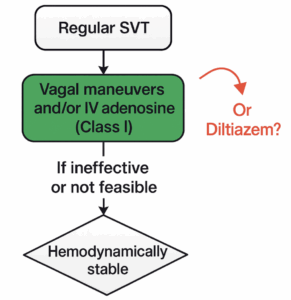by Brandon Bleess, MD EMT-T and Jeremy Cushman, MD, MS, EMT-P, FACEP, FAEMS
Case:

A 54-year-old male is working in his yard when he collapses to the ground and his wife calls 911. The call is dispatched as a cardiac arrest and the patient\’s wife is instructed to perform CPR per pre-arrival instructions. Upon EMS arrival, the patient is found to be apneic and pulseless. EMS relieves the patient’s wife and compressions are continued while the patient is connected to the monitor. The monitor is charged prior to the next pulse check where the patient is noted to be in ventricular fibrillation. Everyone takes the time to drop contact with the patient as the operator declares “everyone clear” before shocking and resuming compressions and ventilation.
When debriefing the case, one of the paramedics brings up the idea of hands-on defibrillation that he attended a lecture on at a recent conference. Is it safe to defibrillate a patient while CPR is actively being performed?
The Evidence For:
There is little question that high quality, continuous compressions improve neurologic outcomes in patients with out-of-hospital cardiac arrest. The choice of outcome here is important: compressions are really to maintain some oxygenated blood flow to the brain in order to keep it alive long enough to get the heart started again. All too often, ROSC is achieved but the patient has anoxic brain injury which can be a result of extended down time or ineffective compressions.
Thus the goal in performing compressions is to minimize interruptions, for every time compressions are stopped it takes a significantly longer time to return to the flow state that existed just prior to stopping them [1-5]. With the goal of increasing compression fraction and thus improving neurologic outcomes, the American Heart Association (AHA) began recommending charging the defibrillator during chest compressions in 2005 [6]. Multiple studies have since demonstrated that charging during compressions decreases both post- and peri-shock pauses [7-9]. These included the Resuscitation Outcomes Consortium (ROC) PRIMED trial which found that the median peri-shock pause was reduced from 21 seconds to 9 seconds with compressions during charging. This reduction in peri-shock pause lead to a significant increase in mean chest compression fraction (0.77 vs 0.70, 95% CI: 0.03-0.11), an independent factor in increasing survival [9, 10, 11]. Thus, the traditional analyze – charge – shock pattern should be changed to charge – analyze- shock.
But can we go one step further and continue CPR during defibrillation? After decades of “I’m clear, you’re clear, we’re all clear,” it might be time to let that go the way of the backboard in the closet of EMS dogma. Traditionally, external defibrillation has been considered a safety hazard to rescuers and clearing the patient is an almost universal practice, but there is little data to support this notion in the age of adherent defibrillation pads [12]. Indeed, there is now evidence to suggest that hands-on defibrillation is actually safe.
How much energy is potentially transferred to the compressor during hands-on defibrillation? Defibrillators generally deliver 30-40 A of current with each shock, and the threshold for perception is 2.5-4.0 mA, and exposure becomes painful at 6-10 mA. In healthy adults 200-500 mA of current is thought to be needed to induce ventricular fibrillation with incidence correlating linearly to increasing current [12].
Lloyd et. al. found that the amount of “leakage” (the amount of current going to the provider) in an ideal setting (outpatient cardiac electrophysiology evaluations) was well below the allowable minimum [13]. Keep in mind, this study was looking at microamps of current. The allowable being 3,500 microamps and the leakage was an order of magnitude less than that. To put this into further perspective, when pacing patients with transcutaneous pacing generally 60-80 mA is required for capture. Compared to the study’s mean leakage of 283 µA or 0.28 mA, transcutaneous pacing uses over 200 times the amperage to create capture.
Neumann et al. in 2012 followed up this study by inducing ventricular fibrillation in a swine model and comparing hands-on versus hands-off defibrillation. They found that in the hands-on group, chest compressions were interrupted for 0.8% versus 8.2% of the total CPR time (P=0.0003) and coronary perfusion pressure was restored earlier to its pre-interruption level (P=0.0205). They also found that not only was the defibrillation shock imperceptible, but the compressor wearing a cardiac monitor had no arrhythmias noted [14].
Insulating the provider from current leakage is probably one of the easiest ways to protect the compressor from harm. This was studied by Deakin et al. in 2015 using Class 1 electrical insulating gloves while simulating hands-on defibrillation. They found that the median current leakage was 20 μA from the 61 shocks studied, and even at 360 J the median current leakage was 27 μA. The highest recorded leakage was 28 μA, all below the 1 mA threshold they set [15]. More recently in 2016, Wampler et al. published a study looking at perception of shocks using multiple insulating barriers, including nitrile gloves, firefighting gloves, a neoprene pad, and a manual compression/decompression device. Out of the 100 shocks with no barrier device, all but 1 shock was not detected. Out of 500 shocks, only 5 were detected by the compressor – none causing harm, and most importantly the CPR puck prevented any detection [16].
The Evidence Against:
Closer evaluation of these studies may give some rescuers pause. In the 2008 Lloyd study, 8 of the 72 phases (36 shocks, 11.1%) exceeded the 500 µA threshold [13]. In the Neumann study of 2012, the compressors wore 2 pairs of polyethylene gloves which is outside the standard practice of many providers [14]. While Deakin’s study presents some very convincing data in relation to the safety, the compressor was wearing Class 1 electrical insulating gloves. According to the Occupational Safety and Health Administration (OSHA) regulation 29 CFR 1910.137, Class 1 gloves are rated for a maximum usage of 7500 V AC and are proof tested to 10,000 VAC and 40,000 VDC [18]. Defibrillators typically fall well below this at around 2700 V for a biphasic defibrillator.
In 2014, Lemkin et. al. published a cadaver study where they measured the differential of the voltages at various points on the body with several skin preparations (bare, water, saline, ultrasound gel). This allowed them to collect the resistance and exposure voltage in relation to anatomic landmarks to create a map of the providers’ exposure. From there, they derived a formula to measure the rescuer-received dose (RRD) to represent the proportion of energy the rescuer could receive from a shock to a patient. Their results demonstrated the rescuer-exposure could exceed 1 J in any location at some energy level, and reached as high as 9.4J on the anterior chest wall [17]. The argument made is that 1 J could potentially cause a provider to be shocked into ventricular fibrillation themselves. Since this does not include any barriers, it would apply if there was a large tear in the glove or the rescuer was contacting the patient without any gloves.
Conclusion:
While the literature suggests that hands-on defibrillation is safe, it should occur at the discretion of the compressor who should consider wearing two pairs of gloves or utilize both gloves and a CPR-feedback device if performing the procedure. There are no studies that have measured the effect of this on clinical outcome, although it is postulated that increased compression fraction is a useful surrogate. At minimum, the charge-analyze-shock method should be used during every defibrillation to minimize the hands-off time and increase the compression fraction.

For additional Resources, REBEL EM published the following review of Hands-On-Defibrillation: CPR Hands-On or Hands-Off Defibrillation
EMS MEd Editor: Maia Dorsett (@maiadorsett)
References:
1. Berg RA, Sanders AB, Kern KB, et al. Adverse hemodynamic effects of interrupting chest compressions for rescue breathing during cardiopulmonary resuscitation for ventricular fibrillation cardiac arrest. Circulation. 2001 Nov 13;104(20):2465-70.
2. Cunningham LM, Mattu A, O’Connor RE, Brady WJ. Cardiopulmonary resuscitation for cardiac arrest: the importance of uninterrupted chest compressions and cardiac arrest resuscitation. Am J Emerg Med. 2012 Oct;30(8):1630-8.
3. Paradis NA, Martin GB, Rivers EP, et al. Coronary perfusion and the return of spontaneous circulation in human cardiopulmonary resuscitation. JAMA. 1990 Feb 23;263(8):1106-13
4. Hazinski MF, Nolan JP, Aicken R, et al. Part 1: executive summary: 2015 International Consensus on Cardiopulmonary Resuscitation and Emergency Cardiovascular Care Science With Treatment Recommendations. Circulation. 2015;132(16)(suppl 1).
5. Neumar RW, Shuster M, Callaway CW, et al. Part 1: executive summary: 2015 American Heart Association Guidelines Update for Cardiopulmonary Resuscitation and Emergency Cardiovascular Care. Circulation. 2015;132(18)(suppl 2).
6. 2005 American Heart Association Guidelines for Cardiopulmonary Resuscitation and Emergency Cardiovascular Care. Circulation. 2005;112:IV1–IV203.
7. Perkins GD, Davies RP, Soar J, Thickett DR. The impact of manual defibrillation technique on no-flow time during simulated cardiopulmonary resuscitation. Resuscitation. 2007;73:109–114.
8. Edelson DP, Robertson-Dick BJ, Yuen TC, et al. Safety and efficacy of defibrillator charging during ongoing chest compressions: a multi-center study. Resuscitation. 2010;81(11), 1521-1526.
9. Cheskes S, Schmicker RH, Verbeek PR, Salcido DD, Brown SP, Brooks S, Menegazzi JJ, Vaillancourt C, Powell J, May S, et al. The impact of peri-shock pause on survival from out-of-hospital shockable cardiac arrest during the Resuscitation Outcomes Consortium PRIMED trial. Resuscitation. 2014 Mar; 85(3):336-42.
10. Christenson J, Andrusiek D, Everson-Stewart S, et al. Chest compression fraction determines survival in patients with out-of-hospital ventricular fibrillation. Circulation. 120 (2009), pp. 1241-1247.
11. Cheskes S, Schmicker RH, Christenson J, et al. Peri-shock pause: an independent predictor of survival from out-of-hospital shockable cardiac arrest. Circulation. 124 (2011), pp. 58-66.
12. Brady W, Berlat JA. Hands-on defibrillation during active chest compressions: eliminating another interruption. Am J Emerg Med. 2016 Nov;34(11):2172-2176.
13. Lloyd MS, Heeke B, Walter PF, Langberg JJ. Hands-on defibrillation: an analysis of electoral current flor through rescuers in direct contact with patients during biphasic external defibrillation. Circulation. 2008 May 13;117(19):2510-4.
14. Neumann T, Gruenewald M, Lauenstein C, Drews T, Iden T, Meybohm P. Hands-on defibrillation has the potential to improve the quality of cardiopulmonary resuscitation and is safe for rescuers—a preclinical study. J Am Heart Assoc. 2012 Oct;1(5):e001313.
15. Deakin CD, Thomsen JE, Løfgren B, Petley GW. Achieving safe hands-on defibrillation using electrical safety gloves—a clinical evaluation. Resuscitation. 2015 May;90:163-7.
16. Wampler D, Kharod C, Bolleter S, Burkett A, Gabehart C, Manifold C. A randomized control hands-on defibrillation study- Barrier use evaluation. Resuscitation. 2016 Jun;103:37-40.
17. Lemkin DL, Witting MD, Allison MG, Farzad A, Bond MC, Lemkin MA. Electrical exposure risk associated with hands-on defibrillation. Resuscitation. 2014 Oct;85(10):1330-6
18. https://www.grainger.com/content/qt-electrical-safety-gloves-inspection-262



